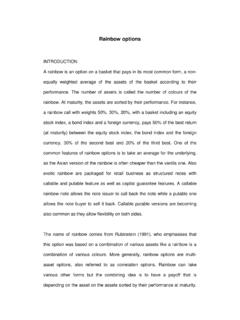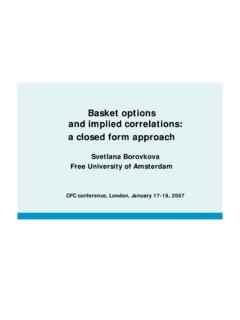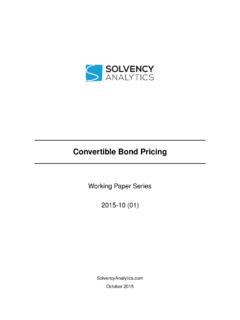Transcription of Jump-Diffusion Models for Asset Pricing in …
1 Birge and V. Linetsky (Eds.),Handbooks in OR & MS, Vol. 15 Copyright 2008 Elsevier All rights reservedDOI: (07)15002-7 Chapter 2 Jump-Diffusion Models for Asset Pricing inFinancial KouDepartment of Industrial Engineering and Operations Research, Columbia this survey we shall focus on the following issues related to Jump-Diffusion mod-els for Asset Pricing in financial engineering. (1) The controversy over tailweight ofdistributions. (2) Identifying a risk-neutral Pricing measure by using the rational ex-pectations equilibrium. (3) Using Laplace transforms to Pricing options, includingEuropean call/put options, path-dependent options, such as barrier and lookback op-tions. (4) Difficulties associated with the partial integro-differential equations relatedto barrier-crossing problems. (5) Analytical approximations for finite-horizon Amer-ican options with jump risk. (6) Multivariate Jump-Diffusion is a large literature on Jump-Diffusion Models in finance, includingseveral excellent books, the books byCont and Tankov (2004), Kijima(2002).
2 So a natural question is why another survey article is needed. What weattempt to achieve in this survey chapter is to emphasis some points that havenot been well addressed in previous surveys. More precisely we shall focus onthe following issues.(1) The controversy over tailweight of distributions. An empirical motiva-tion for using Jump-Diffusion Models comes from the fact that assetreturn distributions tend to have heavier tails than those of normal dis-tribution. However, it is not clear how heavy the tail distributions are,as some people favor power-type distributions, others exponential-typedistributions. We will stress that, quite surprisingly, it is very difficultto distinguish power-type tails from exponential-type tails from empir-ical data unless one has extremely large sample size perhaps in theorder of tens of thousands or even hundreds of thousands. Therefore, Kouwhether one prefers to use power-type distributions or exponential-typedistributions is a subjective issue, which cannot be easily justified empir-ically.
3 Furthermore, this has significant implications in terms of definingproper risk measures, as it indicates that robust risk measures, suchas VaR, aredesirablefor external risk management; seeHeyde et al.(2006).(2) Identifying a risk-neutral Pricing measure by using the rational expec-tations equilibrium. Since Jump-Diffusion Models lead to incompletemarkets, there are many ways to choose the Pricing measure; popularmethods include mean variance hedging, local mean variance hedging,entropy methods, indifference Pricing , etc. Here we will use the ratio-nal expectations equilibrium, which leads to a simple transform fromthe original physical probability to a risk-neutral probability so that wecan Pricing many assets, including zero-coupon bonds, stocks, and deriv-atives on stocks, simultaneously all in one framework.(3) Using Laplace transforms to Pricing options, including European calland put options, path-dependent options, such as barrier options andlookback options.
4 We shall point out that even in the case of Europeancall and put options, Laplace transforms lead to simpler expressionsand even faster computations, as direct computations may involve somecomplicated special functions which may take some time to computewhile Laplace transforms do not.(4) Difficulties associated with the partial integro-differential equations re-lated to barrier-crossing problems. For example: (i) Due to nonsmooth-ness, it is difficult to apply It formula and Feymann Kac formula di-rectly. (ii) It is generally difficult to solve the partial integro-differentialequations unless the jump sizes have an exponential-type distribution.(iii) Even renewal-type arguments may not lead to a unique martingale arguments may be helpful in solving the problems.(5) Two analytical approximations for finite-horizon American options,which can be computed efficiently and with reasonable accuracy.
5 (6) Multivariate Jump-Diffusion a survey article, inevitably I will skip some important topics which are be-yond the expertise of the author. For example, I will omit numerical solutionsfor Jump-Diffusion Models ; seeCont and Tankov (2004), Cont and Voltchkova(2005)and d Halluin et al. (2003)on numerical methods for solving partialintegro-differential equations, andFeng and Linetsky (2005)and Feng et al.(2004)on how to price path-dependent options numerically via variationalmethods and extrapolation. Two additional topics omitted are hedging (for asurvey, see the book byCont and Tankov, 2004) and statistical inference andeconometric analysis for Jump-Diffusion Models (for a survey, see the book bySingleton, 2006). Due to the page limit, I will also skip various applications ofthe Jump-Diffusion Models ; see the references inGlasserman and Kou (2003)for applications of Jump-Diffusion Models in fixed income derivatives and termCh.
6 2. Jump-Diffusion Models for Asset Pricing in Financial Engineering75structure Models , andChen and Kou (2005)for applications in credit risk andcredit Empirical stylized Are returns normally distributedConsider the daily closing prices of S&P 500 index (SPX) from Jan 2, 1980to Dec 31, 2005. We can compute the daily returns of SPX, either using thesimple returns or continuously compounded returns. The (one-period) simplereturn is defined to beRt={S(t) S(t 1)}/S(t 1)at timet,whereS(t)isthe Asset price. For mathematical convenience, the continuously compoundedreturn (also called log return) at timet,rt=lnS(t)S(t 1), is very often also used,especially in theoretical modeling. The difference between simple and log re-turns for daily data is quite small, although it could be substantial for monthlyand yearly data. The normalized daily simple returns are plotted inFig. 1,sothat the daily simple returns will have mean zero and standard deviation see big spikes in 1987.
7 In fact the max and min (which all occurred during1987) are about and 21 1550 standard deviation. The continuouslycompounded returns show similar features. Note that for a standard normalFig. 1. The normalized daily simple returns of S&P 500 index from Jan 2, 1980 to Dec 31, 2005. Thereturns have been normalized to have mean zero and standard deviation KouFig. 2. Comparison of the histogram of the normalized daily returns of S&P 500 index (from Jan 2,1980 to Dec 31, 2005) and the density ofN(0 1). The feature of a high peak and two heavy tails ( leptokurtic feature) is quite variableZ,P(Z < 21 1550) 1 4 10 107; as a comparison, notethat the whole universe is believed to have existed for 15 billion years or 5 we plot the histogram of the daily returns of 2displays thehistogram along with the standard normal density function, which is essentiallyconfined within ( 3, 3). Leptokurtic distributionsClearly the histogram of SPX displays a high peak and asymmetric heavytails.
8 This is not only true for SPX, but also for almost all financial Asset prices, US and world wide stock indices, individual stocks, foreign exchange rates,interest rates. In fact it is so evident that a name leptokurtic distribution isgiven, which means the kurtosis of the distribution is large. More precisely, thekurtosis and skewness are defined asK=E (X )4 4 ,S=E (X )3 3 ; for thestandard normal densityK=3. IfK>3 then the distribution will be calledCh. 2. Jump-Diffusion Models for Asset Pricing in Financial Engineering77leptokurtic and the distribution will have a higher peak and two heavier tailsthan those of the normal distribution. Examples of leptokurtic distributionsinclude: (1) double exponential distribution with the density given byf(x)=p 1e x 11{x>0}+(1 p) 2ex 21{x<0} (2)t-distribution, estimate skewness and kurtosis, we shall use S=1(n 1) 3n i=1(Xi X)3 K=1(n 1) 4n i=1(Xi X)4as sample skewness and sample kurtosis, where is the sample standard devi-ation.
9 For the daily returns of the SPX data, the sample kurtosis is about skewness is about 1 73; the negative skewness means the return has aheavier left tail than the right leptokurtic feature has been observed since 1950 s. However classicalfinance Models simply ignore this feature. For example, in the Black ScholesBrownian motion model , the stock price is modeling as a geometric Brownianmotion,S(t)=S(0)e t+ W(t), where the Brownian motionW(t)has a nor-mal distribution with mean 0 and is called the drift, whichmeasures the average return, and is called the volatility which measures thestandard deviation of the return distribution. In this model , the continuouscompounded return, ln(S(t)/S(0)), has a normal distribution, which it is notconsistent with leptokurtic feature. Many alternative Models , Models withjumps and/or stochastic volatility, have been proposed to incorporate the fea-ture, as we will discuss some of them Power tails and exponential tailsIt is clear that the returns of stocks have two tail distributions heavier thanthose of normal distribution.
10 However, how heavy the stock tail distributionsare is a debatable question. Two main classes proposed in the literature arepower-type tails and exponential-type tails. For example, we say that the righttail of a random variableXhas a power-type tail ifP(X > x) cx ,x>0, asx , and the left tail ofXhas a power-type tail ifP(X < x) cx ,x>0,asx . Similarly, we say thatXhas a right exponential-type tail ifP(X >x) ce x,x>0, and a left exponential-type tail ifP(X < x) ce x,x<0, asx .As pointed out byKou (2002, p. 1090), one problem with using power-typeright tails in modeling return distributions is that the power-type right tails can-not be used in Models with continuous compounding. More precisely, supposethat, at time 0, the daily return distributionXhas a power-type right tail. Thenin Models with continuous compounding, the Asset price tomorrowA( t)isgiven byA( t)=A(0) a power-type right tail, it is clear thatE(eX)=.

















